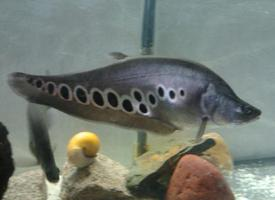
Cunoscut și ca
- Nožovec skvrnitý
- Nožovec čitala
Greutăți și măsuri
| Lungime | de la 90 la 100 cm |
|---|
Descrierea animalului
The Indian featherback, scientifically known as Chitala chitala, is an intriguing and somewhat enigmatic species of freshwater fish that is native to the inland waters of South Asia, particularly in regions of India, Bangladesh, Nepal, and Pakistan. This species is part of the Notopteridae family, which is commonly referred to as the featherbacks or knifefishes due to their distinctive body shape and swimming style.Physical Description:
The Indian featherback is characterized by its elongated, laterally compressed body which gives it a knife-like appearance. This unique body shape is highly streamlined, allowing the fish to navigate with ease through its aquatic habitat. The most striking feature of Chitala chitala is its long, undulating dorsal fin, which runs almost the entire length of its back. Unlike many other fish, the Indian featherback lacks a caudal (tail) fin, and its dorsal fin serves as the main propulsive force for swimming. This fin undulates in a wavelike motion, propelling the fish forward and allowing for precise movements and sudden changes in direction.
The Indian featherback typically reaches a length of about 30 to 90 centimeters, although some individuals have been known to grow up to 120 centimeters. The body is covered in large, silvery scales that reflect light, creating a shimmering effect in the water. These scales can also feature a pattern of dark spots or blotches, which provides the fish with camouflage against the muddy or sandy bottoms of rivers and lakes.
Habitat and Behavior:
Chitala chitala is primarily found in the slow-moving waters of rivers, lakes, and floodplains. They prefer habitats with abundant vegetation and submerged logs or other structures that provide shelter and hunting grounds. The Indian featherback is a nocturnal species, meaning it is most active during the night when it searches for food.
Diet:
As a carnivorous species, the Indian featherback's diet consists mainly of smaller fish, crustaceans, and insects. It is an opportunistic predator, often lying in wait to ambush its prey. The fish's slender form allows it to dart out quickly from its hiding spot to capture unsuspecting prey with its large, protractile mouth.
Reproduction:
The reproductive habits of the Indian featherback include seasonal migration to spawning grounds during the monsoon season. The fish are known to undertake these migrations in groups, and once they reach suitable spawning areas, they engage in a courtship display that involves dancing and nudging behaviors. Females lay eggs among vegetation, where they adhere to plants until hatching. The parents do not provide any care for the eggs or the fry.
Conservation Status:
The Indian featherback faces several threats, including habitat loss due to the construction of dams, pollution, overfishing, and the introduction of invasive species. These factors have led to a decline in their population in some areas. As a result, Chitala chitala is listed as "Vulnerable" on the IUCN Red List of Threatened Species, indicating that it is at risk of becoming endangered if the circumstances threatening its survival and reproduction continue.
In addition to its ecological role, the Indian featherback is also of cultural significance in its native regions and is often featured in local folklore and mythology. It is also valued as a food fish and is sometimes kept as an ornamental species in home aquariums, although its large size and specialized care requirements can make it a challenging pet.
Overall, the Indian featherback is a fascinating species with a unique appearance and biology that contributes to the rich biodiversity of South Asian freshwater ecosystems. Conservation efforts are essential to ensure the survival of this distinctive fish for future generations to appreciate and study.
Fotografii noi cu animale
Top 10 animale
- Diana monkey (Cercopithecus diana)
- Dolphin gull (Leucophaeus scoresbii)
- Galápagos tortoise (Geochelone nigra complex)
- Moustached guenon (Cercopithecus cephus)
- Japanese spider crab (Macrocheira kaempferi)
- Colossal squid (Mesonychoteuthis hamiltoni)
- Fox tapeworm (Echinococcus multilocularis)
- Stone loach (Barbatula barbatula)
- Japanese macaque (Macaca fuscata)
- Barbary macaque (Macaca sylvanus)